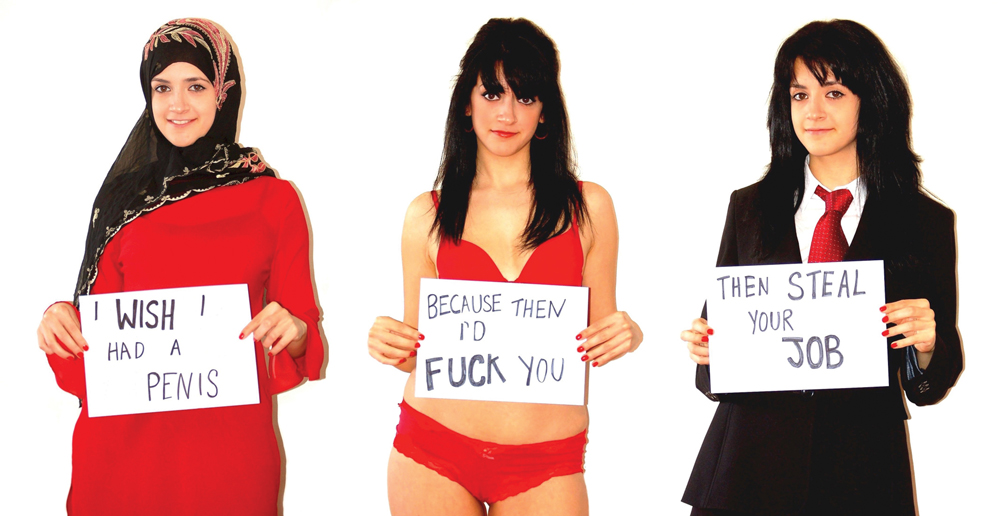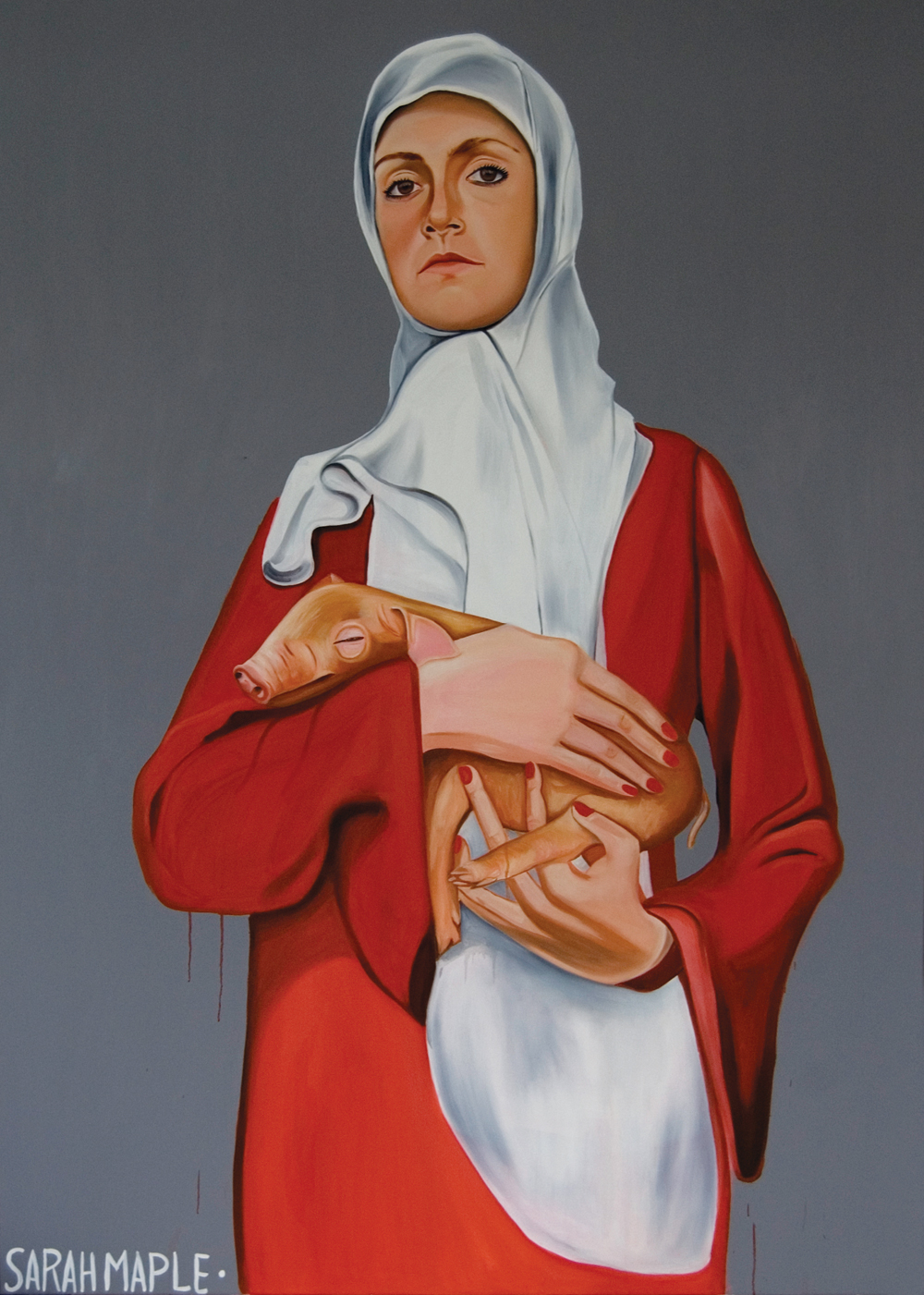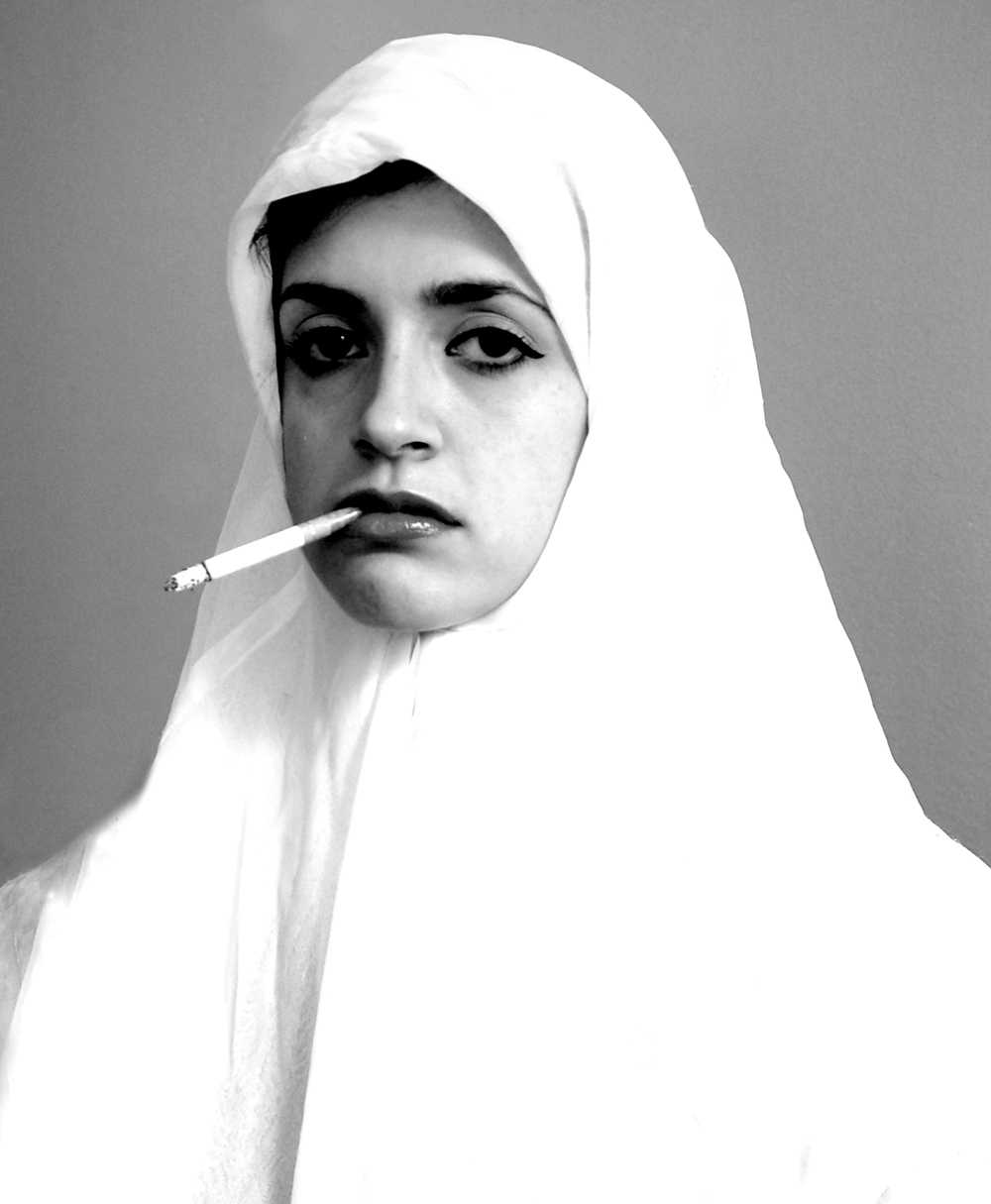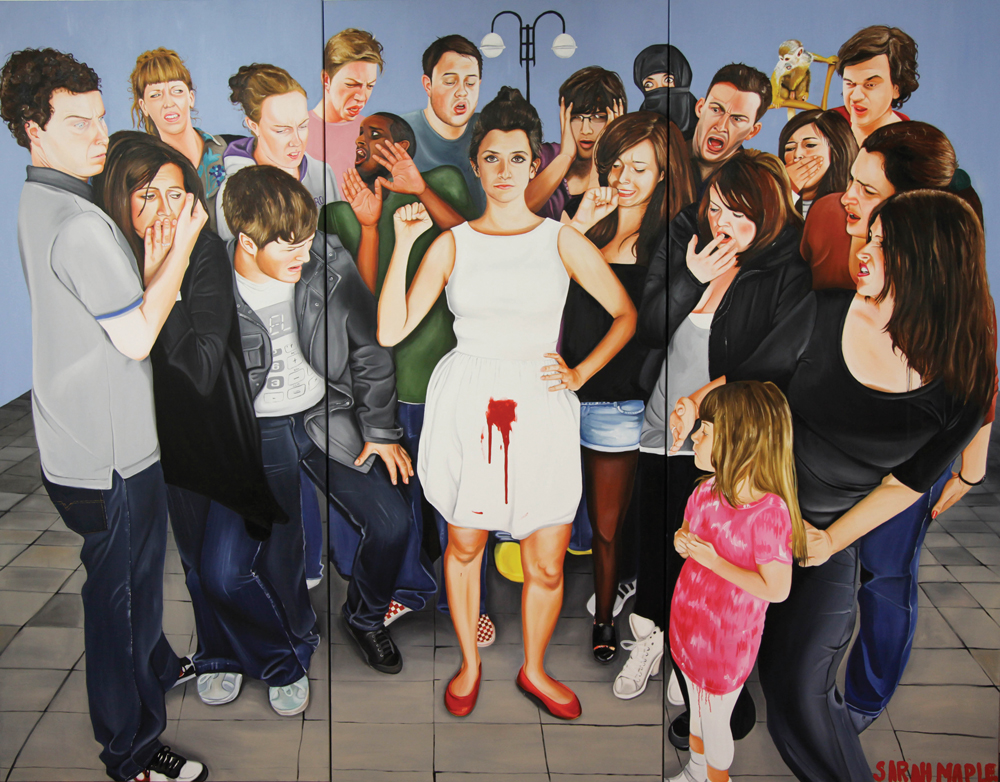« Features
Humor + Feminism + Art=Sarah Maple
By Anne Swartz
“She’s relying purely on being an attractive Muslim.” Much of the critique of Sarah Maple’s artwork comes down to this anonymous comment on myartspace.com several years ago. Maple uses her images to draw the viewer into her maelstrom, fighting against any insidious social and cultural pressures. Then, once there, she springs her message on the viewer, almost unrelenting in her feminist activism. She has taken the “F” in “feminism” and turned it into serious humo, poking fun at gender, cultural and religious-based assumptions in her paintings, photographs and performances and immediately upends the viewer’s presumptions. While the female body has been criticized and scrutinized, treated as a commodity and otherwise sabotaged, Maple has figured out ways to utilize these attitudes and disrupt them. She’s an incendiary artist who uses her experiences with and observations of discrimination as the central component of her art.

Sarah Maple, Signs (I wish I had a penis), 2007, C-type photograph. All images are courtesy of the artist.
Maple is a staunch supporter of gender equality, also known as feminism, promoting its content with her spot-on renderings and snarky references to the viewer’s presumptions and assumptions about women, girls and young women, attractive women, Muslim women and women artists. In a way, she has taken up the activist mantle from the American feminist activist group the Guerrilla Girls, who turned to humor to get the conversation about feminism and art started, and to keep it progressing while the viewer is laughing and thinking. Maple uses her girlishness and sexiness and our desire to draw us into her world and then upends our expectations, also getting us laughing and thinking.
I spoke to Maple in March to discuss her work and its impact.1 Concerning humor in her work she says, “Comedy is a great tool to give audience food for thought. That’s why I choose to portray my conceptual ideas through a light-hearted and tongue-in-cheek approach.”2 In the “Satire” issue of the 1970s and ‘80s feminist art publication Heresies, the editors define the importance of humor in confronting cultural phobias. This definition closely resonates with Maple’s brand of humor: “Satire, like caricature, must above all be intelligent, insolent, precise, and funny,” they said. “It must be merciless, unrepentant, probing, and distressing to its targets. It’s not sledgehammer slapstick, it’s not sheer insult, and it’s not gags. Satire is eminently sociological; without a point of view or an analysis, one cannot produce it…[B]ut satire takes aim at a chunk of the social or cultural order, and at its most effective, it may even (in certain times and places) be an aid to elimination, an enema in the polluted channels of the Establishment (sic). Satire, like feminism, envisions change.”3
Maple was born in Eastbourne, Sussex, in southern England in 1985 to an Iranian Muslim mother and an English father, who was raised Christian and then converted when he married. Her mother was disowned by her family for the marriage; it was a union that would eventually end in divorce when the artist was a teenager. Maple describes her family as “not really traditional, with my mother wearing a headscarf [(only)] when praying. But no one really wore a headscarf but my grandmother.” While her father converted to Islam for marriage, he didn’t follow it that closely either. In several works, Maple shows herself in a burka, which she purchased on eBay.
The religious distinction of being a Muslim in predominantly white Anglican England made an impression on the young Maple. She noted the isolation: There was no mosque in her area; instead, believers met to worship in alternate sites such as restaurants. She says, “Where I grew up, which was white middle class, there really were not any Muslim people, apart from my own family. I didn’t really want to fit in and I wanted to fit in culturally with Muslim people. I felt difficulty embracing my Westernized side.” Maple describes herself as a “Muslim with a white face” and “torn between two cultures.” She remarked: “I really wanted to be a ‘good’ Muslim, but because I’m white, people never thought I was.”4 Heightening her disinterest in the West was her life as a student at a Catholic school, where she felt further alienated by her friends celebrating different holidays than her family. She viewed herself as an outsider and began to use art to critique the reasons for this situation. From an early age she noted the glorified treatment her brother received that she and her sister never did in an otherwise female-dominated extended family.5 Her outlook as a feminist began when a friend told her she was one, even as she said she wasn’t. Denial led to awakening, then to considering it and embracing it.
The change for Maple as an artist occurred while she studied fine art at Kingston University, during which she started “to understand the power and impact of art.” The disjunction she observed at the art critiques at school was striking for the disparity between the male and female students’ experiences.
She found that male students were celebrated and regarded more seriously than their female peers. So she met that discrimination head on in her work. The photographic triptych Signs (I wish I had a penis) of 2007 was the result. The artist used her image three different ways: The first shows the artist smiling, wearing a traditional Islamic dress-a hijab (a veil covering head, shoulders and chest) and salwar kameez (which is the dress and trousers) while holding a sign “I wish I had a penis”; next, we see the heavily made-up artist in red lace underwear with her hair down and a sign reading “Because then I’d fuck you”; and finally, the artist dons a suit and tie with the sign “Then steal your job.” In a single set of images, the artist takes on the most oppressive aspects of the patriarchy, targeting the gender inequities of religion, sex and economics. “That’s the way school was and that’s the way the art world is,” she said. “It is still a man’s world unfortunately. Men take other men seriously.”6
In 2007, while in her last year at university, Maple won the New Sensations national competition coordinated by Channel 4 in partnership with Saatchi Gallery. The goal of the award is to “find the most exciting and imaginative artistic talent in the U.K.” coming out of graduate schools. This recognition immediately catapulted Maple’s work to national and international attention.
Even in her short career, Maple has already courted controversy and rebuked the naysayers. In 2007, she showed images of herself dressed as a conservative Muslim woman, sucking on phallic-shaped objects, among other works. In October and November of 2008, in advance of her debut solo exhibition “This Artist Blows” at Salon Contemporary in the Notting Hill section of west London, her painting Haram (2007) was vociferously rejected by the Muslim community. In it, Maple depicts herself from the head to the hips dressed in a hijab and burka (a full-body cloak) while cuddling a baby pig with what looks like blood dripping off her crooked elbow. About these drips, the artist explained: “It’s not actually intended to be blood, it’s sort of blood-like.”
Haram is the highest level of prohibition or sins in Islam. In advance of the exhibition, Muslim organizations demanded the “offensive” work be removed because of the conservatively dressed woman holding the most disparaged animal in Islam. One community leader called it “an insult in the name of art.”7 As complaints, vandalism, threatening notes and death threats continued the gallery held the exhibit and supported the artist.
Maple targets the suppression and oppression of women in haram, using the traditional dress and animal to get the conversation going. The painting is typical of Maple’s style, with blocks of tints and shades of color and strong outlining highlighting the central subject. The emphasis on her photogenic and attractive appearance and her youthful face and hands adds the sexual layer to this work, in which Maple complicates our impressions about her beauty with the conservative veil and dress and the cuddling of the pig in the place where a Madonna figure would hold the Christ child. Her deadpan expression is a glimpse into the artist’s disinterest in anyone accepting racial, religious and gender stereotyping.
Haram segued into a series of photographs, in which Maple took both Western and Muslim notions of beauty and upended them. In Fighting Fire with Fire Number 2 (2008), the artist in a closely cropped image wears a hijabi headscarf and impassive expression, with a lit cigarette between her lips. The black-and-white medium intensifies both the white of the headscarf and the white ash of the cigarette. The photograph critiques cultural stereotypes by juxtaposing the sooty cigarette with the defiant act of wearing a signifier of purity, the headscarf. Further, smoking is seen as a dirty habit incongruous with the presumed piety of a woman dressed in this way.
In advance of her 2012 solo exhibition “It’s A Girl!,” Maple circulated a photograph as a poster in London titled Lollypop Lollypop (2011). It shows her in a classic airbrushed pinup, holding a large, heart-shaped pink lollypop and wearing a strapless, curve-enhancing outfit covered in lipstick kisses against a candy pink background, with pink makeup on her cheeks. The tease here is that this sexy pose and the props are contradicted by her proud boasting of her hairy armpit, an allusion to the shame and disgust women have been convinced to feel about their bodies, to the point of despising them in the guise of “improving” them. By controlling her image and sexuality and how they are seen, she uses the pinup image and subverts it.8
Maple took on another kind of taboo in the painting Menstruate with Pride (2010-2011); that is, the absolute unspeakable and invisible role menstruation has in society. As a result, she became a menstrual anarchist.9 In it, the artist and crowd around her are in an undefined setting with an ovary and uterine-shaped street light in the background above the center of the scene. She appears twice, first standing in the center with a white dress stained from blood erupting from a genital stigmata. The dripping blood flows over the site of her reproductive organs. One hand is on her hip while she stares straight out with an intransigent gaze at the viewer. Her other hand is in a raised and clenched fist, a long-standing expression of defiance and resistance. The second image of the artist appears in the rear right of the painting as a conservatively attired Muslim woman with shocked eyes and raised brows.
The numerous characters in the painting express a variety of reactions, from horror to embarrassment. At the center, the artist is stoic and poised even when surrounded by complainers and cynics, including a monkey in the upper right corner joining in the confusion. Her healthy, pretty face and body contrast with the disgust associated with this bloody flow. Notably, the one counterpoint is a little girl in the foreground, who seems curious.
Yet, this bodily function is never to appear in public. That Maple’s meditation on menstruation still evokes even a fictive social gag reflex underscores its power. While menstruation is a biological, powerful reproduction function women experience she underscores how visible manifestations remain shameful and repugnant.
In 2013, Maple created Freedom of Speech, a five-minute video about the small and subtle incursions women experience in media, popular culture and contemporary life. Inspired by the hostile backlash against British feminist journalist and activist Caroline Criado-Perez’s successful campaign and petition to the Bank of England for a woman to appear on a bank note to prevent diminishing women’s achievements and accomplishments. Protests ensued, and objectors went to social media, issuing rape and death threats against Criado-Perez. In this video, Maple highlights the cunning, indirect and oft-violent ways women are thwarted by showing herself being slapped by an unseen person as she speaks about the social, popular, cultural and media influences on her work. Ninety seconds into the video, she gets slapped on the face by an unseen person. She continues speaking and the slaps persist, eventually increasing in number. Maple breaks down as the abuse continues, first becoming disoriented, then incoherent, then crying, which the artist said was unplanned. “The abuse beat me down,” she said. Maple explained that stealthy, but treacherous, notions about gender become the standard and we automatically conform to them: “We don’t notice stereotypes anymore and no longer see the absurdity of them.” As a confrontation to the objectors’ complaints that their violent comments should not be removed from social media, they declared that their freedom of speech was compromised, to which the artist responded, “What about my freedom of speech?” She’s attacking women’s self-censorship and the social mechanisms perpetuating it.
For an artist to have created such a powerful statement in her work at this early juncture in her career is significant. We should expect more complexity as she expands her purview to broader issues confronting women. Maple’s self-portraits are provocative and successfully direct the viewer to ask questions about cultural conventions. By slowly and persistently dismantling the slurs and denigration women experience, she has confronted the confusion and pain she felt growing watching boys being treated in so many more interesting ways than girls. Her disruptions are genuinely attention grabbers, and once she’s got us where she wants us, she promotes social change-one art work at a time.
NOTES
1. Online interview with Sarah Maple, March 5, 2014. All quotations not otherwise cited come from this interview.
2. Birgit Rabl, “Oh Girl-It’s A Girl! Investigating with Sarah Maple,” NY Arts, April 2012. <http://www.nyartsmagazine.com/?p=8392>
3. Heresies Collective, “Satire,” Heresies #19, Vol. 5, No. 3 (1985), 2, <http://heresiesfilmproject.org/wp-content/uploads/2011/09/heresies19.pdf>
4. Sarah Maple, as quoted in Aimee Kapfunde, “Sarah Maple,” Ballad of . . . La Courturier (October 16, 2009), <http://balladoffashion.blogspot.com/2009/10/sarah-maple.html>
5. “Sarah Maple [uncut] interview Women Inc. Festival,” video interview (14:19), <http://www.youtuberepeater.com/watch?v=X282V16Wwm8&name=Sarah+Maple+Uncut+interview+Women+Inc+Festival>
6. Ibid.
7. Barry Duke, “Will Muslims go the whole hog and destroy this painting?,” The Freethinker, October 16, 2008, <http://freethinker.co.uk/2008/10/16/will-muslims-go-the-whole-hog-and-destroy-this-painting/> and Kapfunde, Ballad.
8. Not all cultures regard hair under the arms as an issue. When Maple showed this work in Amsterdam, it took an extra moment for the viewers to see the piece in the way she’d intended it. She remarked: “They didn’t see anything because they have a different attitude about women and body hair.”
9. Charlotte Rachael Proudman, “Women, Vaginas and Blood: Breaking menstrual taboos with artist Sarah Maple,” The Independent Blogs, April 13,<http://archive.is/QokV#selection-329.0-329.75>





![6-maple-image-six-freedom-of-speech Sarah Maple, Freedom of Speech, 2013, video still [5:05].](http://artpulsemagazine.com/wp-content/uploads/2014/07/6-maple-image-six-freedom-of-speech.jpg)


































[...] » Features » Humor + Feminism + Art=Sarah Maple. [online] Artpulsemagazine.com. Available at: http://artpulsemagazine.com/humor-feminism-artsarah-maple [Accessed 11 Apr. 2016]. Share this:TwitterFacebookGoogleLike this:Like Loading… Bookmark the [...]